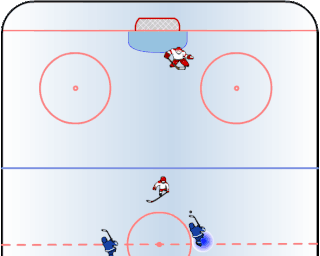
Robert Marvin Hull was a Canadian professional ice hockey player who is widely regarded as one of the greatest players of all time. His blond hair, skating speed, end-to-end rushes, and ability to shoot the puck at very high velocity all earned him the nickname "the Golden Jet". His talents were such that an opposing player was often assigned just to shadow him.

Joseph Eric Thornton is a Canadian former professional ice hockey centre. He played for the Boston Bruins, San Jose Sharks, Toronto Maple Leafs and Florida Panthers of the National Hockey League (NHL). He was selected first overall by the Bruins in the 1997 NHL entry draft and went on to play seven seasons with the club, three as its captain. During the 2005–06 season, he was traded to the Sharks. Splitting the campaign between the two teams, he received the Art Ross and Hart Memorial Trophy as the league's leading point-scorer and most valuable player, respectively, becoming the only player in NHL history to win either award in a season played for multiple teams. Thornton went on to play another 14 seasons with the Sharks, including four seasons as team captain and a run to the 2016 Stanley Cup Finals. Thornton was the last active NHL player and the last big 4 North American sports player to have played in the 1990s.

Daniel Hans Sedin is a Swedish ice hockey executive and former winger who played his entire 17-season National Hockey League (NHL) career with the Vancouver Canucks from 2000 to 2018. Born and raised in Örnsköldsvik, Sweden, Sedin and his identical twin brother Henrik played together throughout their careers; the pair were renowned for their effectiveness as a tandem. During his career, Daniel was known as a goal-scorer, while Henrik was known as a playmaker. Sedin tallied 393 goals and 648 assists in 1,306 games played in the NHL, ranking him as the Canucks' second-highest points scorer all time, behind only his brother Henrik.

Henrik Lars Sedin is a Swedish ice hockey executive and former centre who played his entire 17-season National Hockey League (NHL) career with the Vancouver Canucks from 2000 to 2018. He additionally served as the Canucks' captain from 2010 until his retirement. Born and raised in Örnsköldsvik, Sweden, Sedin and his identical twin brother Daniel played together throughout their careers; the pair were renowned for their effectiveness as a tandem. Henrik, a skilled passer, was known as a playmaker while Daniel was known as a goal-scorer. Sedin tallied 240 goals and 830 assists, for 1,070 points, in 1,330 NHL games, ranking him as the Canucks' all-time leading points scorer.

In ice hockey, an assist is attributed to up to two players of the scoring team who shot, passed or deflected the puck towards the scoring teammate, or touched it in any other way which enabled the goal, meaning that they were "assisting" in the goal. There can be a maximum of two assists per goal. The assists will be awarded in the order of play, with the last player to pass the puck to the goal scorer getting the primary assist and the player who passed it to the primary assister getting the secondary assist. Players who gain an assist will get one point added to their player statistics. When a player scores a goal or is awarded a primary or secondary assist, they will be given a point. The leader of total points throughout an NHL season will be awarded the Art Ross trophy.

Edward Jovanovski is a Canadian former professional ice hockey defenceman. He was born in Windsor, Ontario, and is of Macedonian descent.

Denis Charles Potvin is a Canadian former professional ice hockey defenceman and team captain for the New York Islanders of the National Hockey League (NHL). He is a four-time Stanley Cup winner as a member of the early 1980s New York Islanders. Potvin is also a three-time James Norris Memorial Trophy winner as the NHL's top defenceman. He was elected to the Hockey Hall of Fame in 1991 and served as a commentator for Ottawa Senators' television broadcasts on Sportsnet. Potvin is the former color commentator for the Florida Panthers. In 2017, he was named one of the "100 Greatest NHL Players" in history.

Howard William Morenz was a Canadian professional ice hockey player. Beginning in 1923, he played centre for three National Hockey League (NHL) teams: the Montreal Canadiens, the Chicago Black Hawks, and the New York Rangers. Before joining the NHL, Morenz excelled in the junior Ontario Hockey Association, where his team played for the Memorial Cup, the championship for junior ice hockey in Canada. In the NHL, he was one of the most dominant players in the league and set several league scoring records. A strong skater, Morenz was referred to as the "Stratford Streak" and "Mitchell Meteor" in reference to his speed on the ice.

Sidney Patrick Crosby is a Canadian professional ice hockey centre and captain of the Pittsburgh Penguins of the National Hockey League (NHL). Nicknamed "Sid the Kid" and dubbed "The Next One", he was selected first overall by the Penguins in the 2005 NHL Entry Draft. Born and raised in Halifax, Crosby was considered one of the most lauded prospects in ice hockey history and is widely regarded as one of the greatest ice hockey players of all time.
The 1926–27 NHL season was the tenth season of the National Hockey League. The success of the Boston Bruins and the Pittsburgh Pirates led the NHL to expand further within the United States. The league added three new teams: the Chicago Black Hawks, Detroit Cougars, and New York Rangers, to make a total of ten, split in two divisions. This resulted in teams based in Canada being in the minority for the first time. To stock the teams with players the new teams brought in players from the Western Hockey League, which folded in May 1926. This left the NHL in sole possession of hockey's top players, as well as sole control of hockey's top trophy, the Stanley Cup, which was won by the Ottawa Senators. This was the original Senators' eleventh and final Stanley Cup win. The Senators' first was in 1903.
The 1921–22 NHL season was the fifth season of the National Hockey League (NHL). Four teams each played 24 games. The league dropped the split season and the two top teams played off for the league championship. The second-place Toronto St. Patricks defeated the first-place Ottawa Senators for the league championship.
David Andrew Taylor is a Canadian former professional ice hockey player who played in the National Hockey League (NHL) with the Los Angeles Kings from 1977 to 1994. He featured in the 1993 Stanley Cup Finals with the Kings.
The 1944–45 NHL season was the 28th season of the National Hockey League. Six teams each played 50 games. The Toronto Maple Leafs won the Stanley Cup in seven games versus the Detroit Red Wings.

Evgeni Vladimirovich Malkin is a Russian professional ice hockey centre and alternate captain for the Pittsburgh Penguins of the National Hockey League (NHL). Nicknamed "Geno", Malkin began his career with his hometown club Metallurg Magnitogorsk, playing for their junior and senior teams. He was then selected second overall in the 2004 NHL Entry Draft by the Pittsburgh Penguins, though an international transfer dispute delayed the start of his NHL career until 2006.
Pierre Roland Larouche is a Canadian former professional ice hockey forward who played in the National Hockey League for the Pittsburgh Penguins, Montreal Canadiens, Hartford Whalers, and New York Rangers between 1974 and 1988. He was a two-time Stanley Cup winner with the Canadiens.

Wayne Francis Connelly is a Canadian former ice hockey right winger who played in the National Hockey League with the Boston Bruins, Montreal Canadiens, Minnesota North Stars, Detroit Red Wings, St. Louis Blues, and Vancouver Canucks and finished his career in the World Hockey Association (WHA). Connelly was born in Rouyn, Quebec, and grew up in Teck, Ontario.

Taylor Hall is a Canadian professional ice hockey left winger for the Chicago Blackhawks of the National Hockey League (NHL). He was the first overall pick in the 2010 NHL Entry Draft selected by the Edmonton Oilers. He has previously played for the Oilers, New Jersey Devils, Arizona Coyotes, Buffalo Sabres and Boston Bruins.
The 1975–76 Pittsburgh Penguins season was their ninth in the National Hockey League. They finished third in the Norris Division, as they had in 1974–75. Despite strong seasons by Pierre Larouche, who set new club records in goals scored in a season (53) and points in a season (111), Jean Pronovost and Syl Apps Jr. the Penguins powerful offense scored a meagre three goals in three games against the Toronto Maple Leafs in the preliminary round of the Stanley Cup playoffs, ending their season.

Connor Andrew McDavid is a Canadian professional ice hockey centre and captain of the Edmonton Oilers of the National Hockey League (NHL). Born and raised in Richmond Hill, Ontario, the Oilers selected him first overall in the 2015 NHL entry draft. McDavid is often regarded as one of the best players in the world, and his offensive dominance has drawn comparisons to players such as Sidney Crosby.












